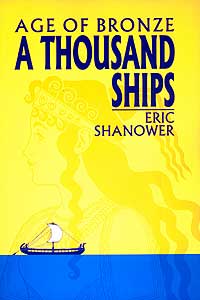
|
On the large scale "Age of Bronze: A Thousand Ships" ($19.95; 224pg; Image Comics) merely tells the back story to Agamemnon's attack on Troy. But this includes the story of Paris, a shepherd who, upon learning he's the lost son of Troy's King Priam, lustily kidnaps Sparta's Queen Helen. Preparing to retaliate, Agamemnon spends three years scheming to gather the thousand ships and heroes prophesied as pivotal to victory. One of these, Achilles, has been hidden among the female charges of a minor king to protect him from his bloody fate. The book ends where most others would begin, as the forces set sail for Troy.
In his afterward Shanower writes, "My purpose in 'A Thousand Ships' isn't to invent, but to tell anew, so I have done my best to base everything on existing sources." To that end he includes a bibliography, a genealogical chart, and a glossary. Even so, he admits that it still amounts to his deciding which version of the tale most suits him, and adding his own details when no others fit. Perhaps classical scholars will wince, but putting a personal spin on history couldn't be more Homeric.
 Achilles gets tired of playing a girl in Eric Shanower's "Age of Bronze: A Thousand Ships"
Achilles gets tired of playing a girl in Eric Shanower's "Age of Bronze: A Thousand Ships" |
Shanower may not create the poetry of "The Iliad" but he tells a story in a straightforward, clean manner that will keep you reading through one sitting. To do it he gives the characters personalities: Paris as adolescent dumbbell, Helen as the ultimate trophy wife who remains stately even while succumbing to an absurd love, and Agamemnon, the opportunist who seeks to consolidate his power. Thus, inevitable historical events seem born out of human mistakes and desires. Throw in some PG-13 sex scenes and a few animal sacrifices, and you've got a good book.
He draws cleanly too. The black and white images are "classically" representational and nicely detailed. You could almost count the hairs in Odysseus' beard. Shanower generally eschews experimentation except during a cartoony flashback, and an occasional toying with event's sequence in time. Comix aesthetes may therefore snuff at its mainstream approach, but on the other hand, you don't need a Ph.D. in comix linguistics to appreciate it.
To that end, "Age of Bronze: A Thousand Ships," would be a fine book to give to your relatives who don't read comix, or as an alternate introduction to the classics for teenagers. And since "Age of Bronze" gets published in chapter format as a regular comicbook, you can continue to enjoy the work without waiting for the next big volume. (The first issue of the second volume should be arriving soon.) You almost pity poor Eric Shanower. By the end of this first book a priest prophesies the Trojan war to last nine years. At the rate Shanower is going, it may take a little longer.
"Age of Bronze: A Thousand Ships" can be found at better comicbook stores
